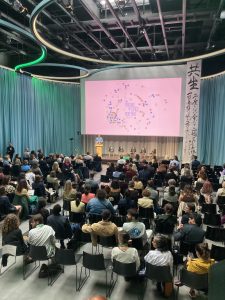TNOC Post-conference reflection. “One space, divergent discourses: the blurry but critical shift from nature OR cities to nature OF cities”.
O. Aminta Estrada-Leyva (Research Assistant, RECONNECT)
July 1 st, 2024. Stockholm, Sweden
Last June, I attended The Nature of Cities (TNOC) Festival in Berlin, Germany. The event brought together a diverse group of researchers, practitioners, and artists from around the world, all sharing a common interest and work with nature in urban contexts. The festival’s setting was as unique as its attendees, with art-filled spaces and sustainably sourced food, creating a relaxed and inclusive atmosphere where spontaneity and informal discussions were plentiful.

TNOC Berlín Plenary Hall, 2024. Own credit.
The festival was designed to facilitate engagement through participatory workshop-style sessions. In these spaces, I observed concepts, theories, and methods aligning with our work at RECONNECT, as well as many new ideas. One concept I encountered was “BiodiverCity”, which recognizes, prioritizes, and integrates biodiversity and its role on improving quality of life, equity, and inclusion while contributing to climate adaptation and resilience. The concept centers on the potential of cities as biodiversity and well-being hotspots, moving beyond the notion of cities as mere environments that contain some nature patches. It critically redefines what a city can be, shifting the discourse from urbanization as a problem to cities as potential spaces for reconnecting people with their environment and more-than-human species with the wider landscape.

BiodiverCity as a focus concept. TNOC Berlín Plenary, 2024. Own credit.
Contrastingly, throughout the festival sessions, I also encountered tendencies to view urban land and ‘wildland’ as dichotomous and non-compatible. For example, when discussing desirable future urban scenarios, many supported and reinforced the idea of densifying cities to preserve as much untouched “pristine” land as possible, thereby preventing urban sprawl and human encroachment. This approach, which leaves cities out of biodiversity conservation actions and strategies, led to discourses of the urban as inherently grey and unnatural, reinforcing sharp boundaries and condemning cities to be seen in this light. This made me think: how can we aim to reconnect people, institutions, and species if the concepts we use and the ideas we share stem from a confrontational stance? If we cannot, then how can we move away from this stance, and towards what should we move?
When discussing connections with surroundings, it becomes inevitable to talk about scales, something this festival was very good at. The discussion around scales, especially the role of nature-based solutions (NbS) from a broader landscape perspective, was very present during the festival. There were many conversations about the role of cities in the wider landscape, both in terms of resource use and biodiversity conservation practices. Concepts such as “Landscapes of Life” and “Nature-Positive Cities” emerged when studying a city as one land use within a larger array of uses, considering its cultural, institutional, and biophysical surroundings. These discussions were fruitful and necessary, as it is only possible to understand cities by understanding their hinterlands’ dynamics and vice versa.
Witnessing these series of discussions and plenaries reinforced my appreciation for research approaches that critically question commonly unquestioned concepts and aim to test theories that make sense at a broader scale. After all, being mindful of and moving away from dichotomous thinking might be one way to reconnect contested and fragmented landscapes and transition towards cities as biodiversity and well-being hotspots.